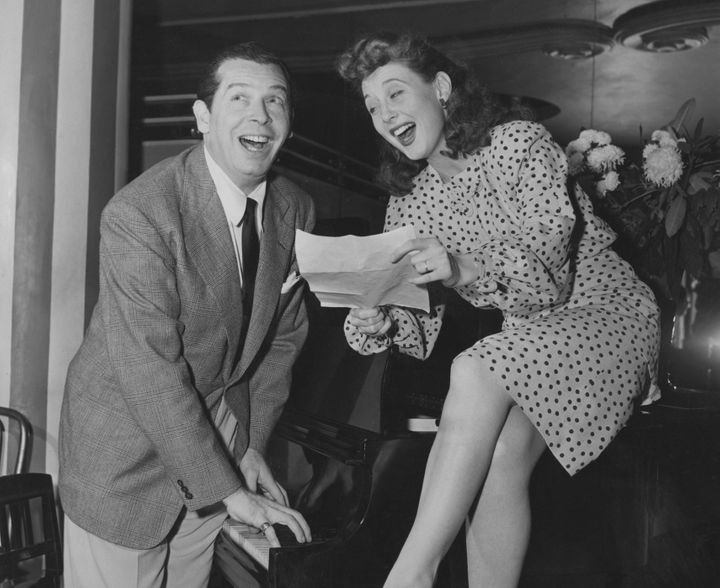Baby, It’s A New Age Outside
February 21, 2020
Just this past winter, there’s a good chance you read a heated tweet or controversial article about the frequently-used argument: the infamous holiday tune “Baby, It’s Cold Outside” is creepy. Every holiday season, writers for popular blogs practically jump with joy at the opportunity to revisit this repeated controversy. Even on Wildezine, articles have been written about the song. You can’t really blame us: other than whenever Hollywood pumps out yet another biopic about some immortalized star, or when the 21st of September rolls around, when do we really see older songs top the charts? In modern culture, we’re fairly underexposed to the real, authentic people of the past, and not beyond the level of a revisionist aesthetic.
As “Baby, It’s Cold Outside” re-enters the public discourse, we once again get collectively angry over its concerning levels of predatory language, the appearance (or lack thereof) of consent, and maybe even date rape drugs. These conclusions are all drawn from the song’s plot of a young woman and her male partner as he urges her to stay later with the titular excuse regarding the weather, while she insists that she must go. But think about it: how much can we really infer about the lyrics of a song that was made almost 80 years ago, taken out of context and placed ungracefully into our modern world? What does it tell us about the setbacks of the time it was created in?
So, let’s take some time to examine this dated holiday hit as what it truly is: a stranger from the past in a new, ever-changing world.
Let’s begin with the origins of the song. Composer Frank Loesser, known for “Guys and Dolls” and several other 40’s hits, wrote “Baby” in 1944 as a playful parlor tune. The idea was for his wife Lynn Garland and himself to sing a light, flirtatious duet for their guests at parties. The two vocal parts he created were originally labelled “wolf” and “mouse.”
(WAIT! Now, I know you just had the same thought I did when seeing those names for the first time, which was something along the lines of, “Oh, Jesus, that’s definitely creepy.” But I want you to tune in to that little voice in your head that associated whatever it did with the words “wolf” and “mouse,” and I want you to try to examine where that voice is coming from. That’s your “modern voice,” and it derives from whatever you’ve learned in the 21st century, and while that voice may be in the right, it’s important to recognize when you think or speak from that place of preconceived notions.)
Yes, that’s right. Wolf and Mouse. Loesser and his wife’s original performance of this
song, while playful between the two of them, did enforce a predator/prey dynamic. Loesser later sold the song’s rights to future adaptations such as the one between Esther Williams and Ricardo Montalban. In their version, the roles of “wolf” and “mouse” actually reversed halfway through, with Williams singing the wolf’s part and Montalban singing the mouse’s for the entire second half of the song. The power dynamic was explored, it was played up, it was dramatized. Even in lines such as the highly discussed “say, what’s in this drink?”––which was, actually, a common party joke and implied not that there was anything dubious in the drink, but rather admiring the various ingredients––can be viewed not as one partner forcefully overtaking the other, but rather a playful exchange between two people leaning into a power-play.
To take things a step further, this dynamic, while our ears may not like the choice of
words, does mirror a fairly modern sexual or romantic set of terminology: the dominant and the submissive partner. In our culture, we have the sexual and emotional freedom to experiment with a consensual shift of power or exploration based on trust, that doesn’t even have to occur in a vulgar sense. Whether in conversation, in initiation, or in communication in general in modern-day romance, we have a heightened understanding of the nuances of power dynamics. Predator/prey in Loesser’s or Williams’ sense is, very likely, just dominant/submissive by another name. Even modern songs that have come on the radio in the past several years have featured gender-dynamics or sexual pursuit that mirror the leader/follower dynamic (Think “Promiscuous” by Timbaland). Now consider: did the people of the 1940’s have the social freedom to call it what we do now?
Speaking of social freedom, let’s discuss another aspect of “Baby”’s lyricism, one that has been touched on in modern discourse yet not fully fleshed out: slut-shaming. As the name implies, for any who may not know, this is (yet another modern) term used to refer to the degradation of women for having sex or behaving sensually. As one can imagine, slut-shaming was absolutely rampant in the 1940’s and onward. For centuries, a woman’s image and “purity” had been of the utmost importance in society. Ads of the 50’s and 60’s were littered with depictions of young women as “temptresses” or “snakes,” equating female promiscuity with evil. No woman was to ever disclose or display desire, or else she was deemed loose and dirty, or even dangerous.
Now, think of the lyrics of “Baby” that the “mouse” sings in response to the “wolf”s advancements, such as, “my mother will start to worry,” “my father will be pacing the floor,” “my maiden aunt’s mind is vicious,” “the neighbors will start to think,” or even, “there’s bound to be talk tomorrow.” In the original version, Loesser has created a female character that gracefully skirts around the possibility of appearing loose or “slutty.” Her excuses for why she cannot stay derive from what she knows is true in the phrase “I ought to say no, no, no sir”; that women do not have the sexual freedom to follow desires, and that the gossip will be boiled down to the bare essentials of her late-night escapade that will evidently tarnish her reputation. In a world like this, can a woman overtly express her interest in a partner? No, she can’t. So then, does she choose to do this in a more obscure sense, through lines such as, “maybe just a half a drink more?” She can’t say yes, but she can not say no, even though as the lines before express, she knows she “ought” to. She can “say that [she] tried.”
(There’s that “modern voice” again. In 2020, we wouldn’t dare imply that “not saying no” is the same as a yes, now would we? But once again, that’s based on what we know––and what’s acceptable––now.)
Today, we often hear the words “enthusiastic yes” thrown around when it comes to consent. Now, while this may appear as a stretch, it is important to understand that this sideways not-denial of his advances may have really been the best that a woman in the 1940’s could give. Is that ideal? No, of course not. It’s a nightmare. Compared to so many platforms for unashamed freedom for women today, it’s dystopian. Men like Loesser himself created this restrictive blockade of social taboos for women and for sex, as we see almost unfortunately showcased in the lyrics of this song. But it provides more context for why the song is the way it is, and gives us a little bit more of an accurate lens through which to view the lyrics.
So, with the evidence brought forward from the context of the song and how that relates to its lyrics, we really get a sense of the stark contrast between the world that “Baby, It’s Cold Outside” was created in, and the privilege that we have of moving farther and farther away from that time. But it is important to understand that even with this context, we don’t have to “like” the song. In fact, some argue that we shouldn’t. With the growing sexual understanding and freedom we continue to develop, it is perfectly reasonable to be angered by the implications in “Baby, It’s Cold Outside,” whether with the language, the issues it perpetuates by highlighting the status quo of the period, or the people who continue to play the song today. It is, unfortunately, done a disservice by being casually thrown onto radio stations when in reality, it requires a whole historical disclaimer alongside it. While times are changing, however, we can also find solace in “Baby.” We can see that, although they didn’t express it the same way, human behavior and intention may not have changed as much as we thought, but rather the way that we communicate it. So, the next time this enigmatic hit comes over the radio in December, instead of angrily changing the channel, why not give the lyrics a deeper listen and see if you even find something more?






